Measures of San Antonio’s Social Capital—Perceptions of Social Networking
By Darla Norton, Research Associate, Juanita M. Firestone, Ph.D., Professor, and Arturo Vega, Ph.D., Associate Professor
Issue:
This issue brief is the second in a series of analyses that examine social capital in Bexar County (San Antonio), Texas. This brief examines levels of social networking. Social networks and networking are integral parts of a community’s social capital or a measure of the levels of social relationships within communities and among individuals. One’s social networks and one’s ability to network are important to general trust, access to information and norms of reciprocity. Typically social networks are distinguished as “bonding” and “bridging” networks. Bonding networks typically occur between homogenous groups, mainly among family members or between individuals with a shared identity (i.e. race/ethnicity, religious). Bridging networks occur between communities by connecting various groups (i.e. religious, ethnic, social, and political) and are useful for social or economic improvements.
The research questions examined here are: What are the levels of social networks (bridging and bonding) in San Antonio, Texas? Are there significant variations in levels of bridging and bonding social capital among aspects of the community?
Data and Methods:
Data for this study were collected during the San Antonio Survey 2003 (SAS 2003), which was conducted during the weeks of October 12-28th, 2003.[i] Responses are from a random probability sample of the general population of adults 18 years of age and older in Bexar County, (San Antonio) Texas, with listed phone numbers. A split sample design produced 423 responses from a random sample of individuals within the county, and an additional oversample of 136 respondents living on San Antonio’s West Side for a total of 559 respondents.[ii] To measure levels of social networking three questions were asked:
- “How frequently have you been in the home of someone from a different neighborhood or had them in your home?” (BRIDGING social network);
- “How frequently have you been in the home of someone from a different race or had them in your home?” (BRIDGING social network); and
- “How frequently have you had friends over to your home?” (BONDING social network).[iii]
Findings:
In response to the question “How frequently have you been in the home of someone from a different neighborhood or had them in your home?” nearly thirty-five (34.9%) percent of respondents replied they “frequently” do, while thirty-nine (39.4%) percent replied they “sometimes do” (see Figure 1). Just over twenty-five (25.7%) percent reported they “never” or “seldom” have been in the home or had someone in their home from a different neighborhood.
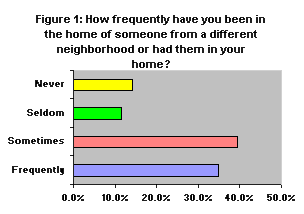 |
When asked “How frequently have you been in the home of someone from a different race or had them in your home?”, over thirty-six (36.3%) percent of the respondents reported “frequently” visit with a person from a different race, while an additional thirty-six (35.7%) percent indicated “sometimes” (see Figure 2). Just over fourteen (14.4%) percent of respondents “never” have a person of a different race at their home or go to their home, while thirteen (13.6%) percent “seldom” do.
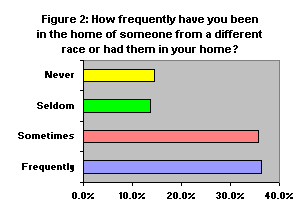 |
Four in ten (41%) respondents reported that they “frequently” have friends over while over one in three (35.3%) said they do “sometimes” (see Figure 3), when asked, “How frequently have you had friends over to your home?” Less than one in four respondents (23.1%) reported that they “never” or “only seldom” visit with someone from a different neighborhood.
Table 1 presents the distributions of the two bridging (NEIGHBORHOODS and VISIT DIFFERENT RACE HOME) and the one bonding (VISIT FRIENDS) questions of social networks by demographic determinants. Reponses to the NEIGHBORHOODS question were statistically significant and moderately associated with age and West Side, but only weakly associated with educational attainment and income. Responses to the VISIT DIFFERENT RACE HOME question were also statistically significant and weakly related with age, income, educational attainment and gender, but moderately
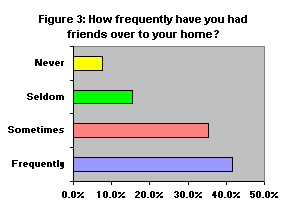 |
associated with race/ethnicity and West Side. Nearly half on the young adults (18-29) frequently visit with someone from a different neighborhood or of a different race, whereas less than a quarter of senior adults (65+) do. Respondents in the lowest income bracket were least likely to “frequently” visit (29.8%) with someone from another neighborhood. This compared to over four in ten respondents in the higher income group. There were no significant differences by income groupings associated with visiting with someone of a different race.
There were also no significant differences in frequency of visiting with someone from a different neighborhood by race or ethnicity. However, African Americans were significantly more likely to “frequently” visit with someone of a different race. In both questions, only three in ten Hispanic respondents reported “frequently” having someone over to their homes from a different neighborhood or a different race and lagged behind their racial/ethnic counterparts.
Levels of educational attainment are also associated with the ‘different neighbors’ and ‘different race’ questions. Here, respondents with less than a high school education are significantly less likely to “frequently” visit with persons from a different neighborhood (9.6%) or with persons of a different race (10.8%) than respondents in higher educated groupings.
Respondents living on the West Side were also significant different in their responses to “neighborhoods” and “visit different race” questions. Here, one fourth (25.3%) of the West side respondents indicated that they “frequently” had been in the home of someone from a different neighborhood or had them in their home compared to nearly four in ten (38.5%) Bexar County respondents. A similar pattern was found when responses were compared for the frequency of having been in the home of someone of a different race or had someone of a different race in their home (23.3% Westsiders vs. 42.1% Other Bexar respondents). No statistically significant differences were found
among respondents living inside or outside Loop 410 as to whether they visited with someone from a different neighborhood or a different race.
In addition, no statistically significant differences were found among male and female respondents as to whether respondents visited with someone from a different neighborhood. However, females were slightly more likely to “frequently” visit with someone of a different race (females 41.3% vs. males 32.9%).
Table 1: Social Interaction (Bridging and Bonding) by Demographic Determinants
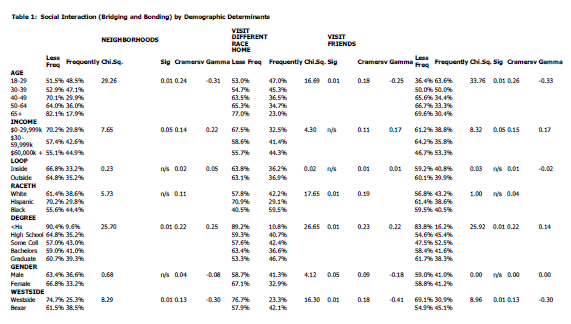 Click on graphic to view PDF version of the table. |
Relative to the bonding social networks of VISITing FRIENDS, younger, wealthier and more educated respondents were more likely to have friends over compared to their counterparts. Here, West side respondents were also statistically different from other Bexar County respondents. Living inside or outside Loop 410, gender and race/ethnicity, on the other hand, made no difference as to whether respondents interacted with friends.
Finally, Figures 4-6 display the dimensions of social networking (NEIGHBORHOOD, VISIT DIFFERENT RACE HOME, and VISIT FRIENDS) by race/ethnicity, controlling for geographic location. Figures 4 and 5 show that when race/ethnicity is controlled by location, Westsiders have lower levels of ‘bridging’ social capital compared to others in Bexar County. Hispanics not living on the West Side (Hispanic (BC)), for example, are more likely to visit with persons from a different neighborhood or of a different race compared to Hispanics from the West Side (different neighborhood: 34.1% vs. 25%; different race: 35.3% vs. 20.2%). A similar pattern exists among Anglos not living on the West side (White (BC)) compared to their counterparts in the West side (different neighborhood: 39.3% vs. 27.3%) (different race: 42.5% vs. 33.3%). In addition, Hispanics and Anglos not living on the West Side are also more likely to visit with friends (bonding) than West side Hispanics and Anglos (Hispanic: 46.8% vs. 26.9%) (Anglo: 44% vs. 33.3%).
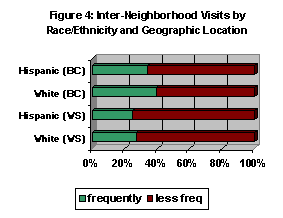 |
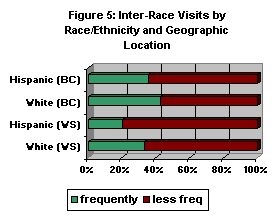 |
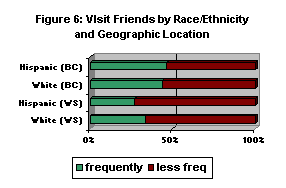 |
Discussion:
Social capital can produce potentially positive benefits to individuals and communities by increasing connectedness, improving access to information and improving opportunities for economic development. Bridging and bonding networks affect the flow of resources and, in particular, bridging capital is crucial to increasing social and economic resources. These points are especially important in an ethnically diverse city such as San Antonio. The above analysis provides evidence that access to bridging and bonding social capital within our community varies according to demographic characteristics and especially according to geographic context. Those residing on the Westside, particularly Hispanics, are less likely to be involved with inter-neighborhood and “inter-racial” visiting, and are even less likely to visit friends. This is partly a result of residential segregation, coupled with the higher levels of poverty and crime on the Westside that appear to reduce friendship visits. These findings are also consistent with findings in Issue Brief 1, which showed lower levels of trust on the Westside. This differential access to social networks unfortunately appears to exclude those who most need it: residents on the Westside, racial and ethnic minorities, the elderly, the poor, and the least educated.
Notes
[i] The SAS 2003 is an annual survey conducted by UTSA students in research methods courses in sociology, criminal justice, kinesiology and public administration, in conjunction with The Culture and Policy Institute. The survey provides students with experience in survey research and an opportunity to measure the attitudes and perceptions of San Antonians on topics of the day. Juanita Firestone, Professor, Department of Sociology, is the principal investigator; Richard Harris, Professor, Department of Sociology, and Arturo Vega, Associate Professor, Department of Public Administration, are co-principal investigators.
[ii] The standard error for the entire sample, including the additional sample from the Westside, is +/- 4.1% with a confidence level of 95%. The SAS 2003 incorporated several questions from the Saguaro Seminar’s “Social Capital Community Benchmark Survey Short Form 2001.” The authors acknowledge the Seminar for its generosity in sharing the short form on line. www.ksg.harvard.edu/saguaro/pdfs/socialcapitalshortform.pdf
[iii] The responses were coded 1 = never, 2 = seldom, 3 = sometimes, 4 = frequently and were then recoded into a dichotomous variables (4 = 1 and 1 thru 3 = 0) in which, 1 = frequently and 0 = less frequently.